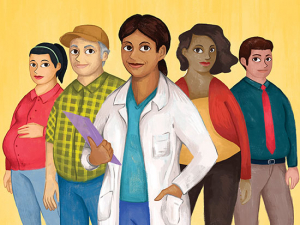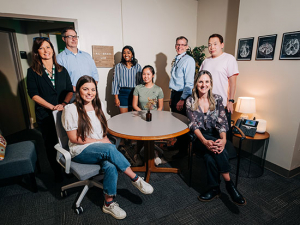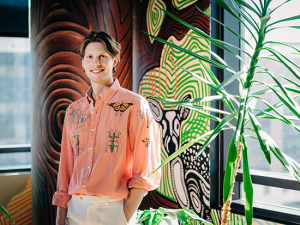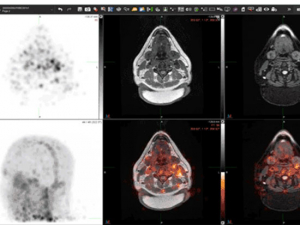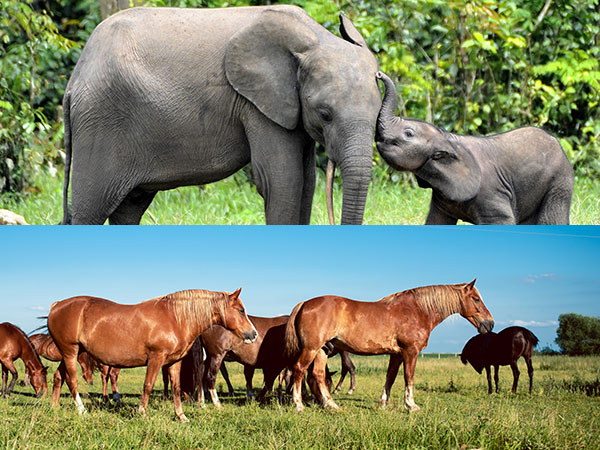 In elephants, as in the majority of mammals studied, females live longer than males. Horses show the opposite pattern. An NSF-funded project led by UAB is gathering data to test common hypotheses explaining sex-related differences in aging.
In elephants, as in the majority of mammals studied, females live longer than males. Horses show the opposite pattern. An NSF-funded project led by UAB is gathering data to test common hypotheses explaining sex-related differences in aging.
Most people know that women tend to live longer than men. This pattern has been observed since accurate birth records began to be kept some 300 years ago. But it is only over the past decade or so that researchers have documented that female/male lifespan divergence occurs on a grand scale across species.
The difference in average longevity seen in humans is even more pronounced among female and male elephants, lions and orcas. Horses, rabbits and some species of bats offer counterexamples where males are more long-lived than females. But the overall balance is still on the female side among mammals. A large 2020 study of 101 mammal species found that the median lifespan of females was 18.6 percent longer than for males. (In humans, females live an average 7.8 percent longer, according to the study.)
This is not just a statistical oddity. Understanding why and how sex differences affect aging rates could point the way to new therapies to boost lifespans. It could increase the food supply — by extending the milk-producing years of cows, for example. And it could offer clues to how to prevent species collapse in the face of climate change.
There are already many hypotheses about the root causes of sex differences in aging, including the wonderfully named “mother’s curse.” What is needed, says Nicole Riddle, Ph.D., associate professor in the Department of Biology, is data from a wide range of species. Those data need to be collected with the latest molecular and genomic techniques to rigorously test the leading hypotheses. And researchers should look at rule-breaking species. Several types of fish can change sex over the course of their lives — kobudai (Asian sheepshead wrasse) can change from females to males; clownfish can change from males to females.
Expertise at “three very different levels”
Riddle is the primary investigator for a five-year, $12.5 million project built to do just that. The Integration Initiative: Sex, Aging, Genomics and Evolution, known as IISAGE, is one of more than a dozen Biological Integration Institutes funded by the NSF to answer “big questions in biology“ that require interdisciplinary research. With the IISAGE team’s NSF funding, announced in 2022, “we could be primed to unlock the most robust understanding of aging we’ve yet known,” Riddle said.
 Nicole Riddle, Ph.D., is lead investigator for IISAGE, the Integration Initiative: Sex, Aging, Genomics and Evolution. The project is funded by a five-year, $12.5 million grant.IISAGE involves 11 researchers at eight institutions: UAB, University of Kansas, University of Houston, Marquette University, Michigan State University, Cornell University, Brown University and the University of Maryland. “Some individuals bring certain species expertise, and some bring certain technical expertise,” Riddle said. “Altogether, we have expertise at three very different levels, from the molecular scale to the level of the individual, and to the population scale.” Most biologists do not tend to work across scales, which siloes findings and prevents researchers from gaining a wider perspective, “but we are able to do that here,” she said.
Nicole Riddle, Ph.D., is lead investigator for IISAGE, the Integration Initiative: Sex, Aging, Genomics and Evolution. The project is funded by a five-year, $12.5 million grant.IISAGE involves 11 researchers at eight institutions: UAB, University of Kansas, University of Houston, Marquette University, Michigan State University, Cornell University, Brown University and the University of Maryland. “Some individuals bring certain species expertise, and some bring certain technical expertise,” Riddle said. “Altogether, we have expertise at three very different levels, from the molecular scale to the level of the individual, and to the population scale.” Most biologists do not tend to work across scales, which siloes findings and prevents researchers from gaining a wider perspective, “but we are able to do that here,” she said.
What kinds of questions will they seek to answer? IISAGE is exploring hypotheses in three main areas, Riddle says.
1. Genomic architecture: Does it matter how you set up your sex?
Humans have X and Y sex chromosomes: Men have one X and one Y chromosome, while women have two X chromosomes. “But there are also organisms that do that differently,” Riddle said. “There are ones where the females have two different chromosomes, and the males have identical chromosomes. And turtles and alligators don’t have any at all. It is the temperature where the eggs are incubated that determines the sex of the offspring.”
Also, the X and Y chromosomes in humans are not the same size, so males and females have different amounts of DNA, Riddle said. “You have to keep all of that under control and safe. There are lots of things that come along with these sex chromosomes.”
By studying the genomic architecture of different species, IISAGE can answer this question: “Does it matter how you set up your sex?” Riddle said. “Do you still have sex differences in aging? Turtles do. Right now, we have a little bit of data. We are trying to get data from more species to figure out if that is a general pattern or turtle-specific.”
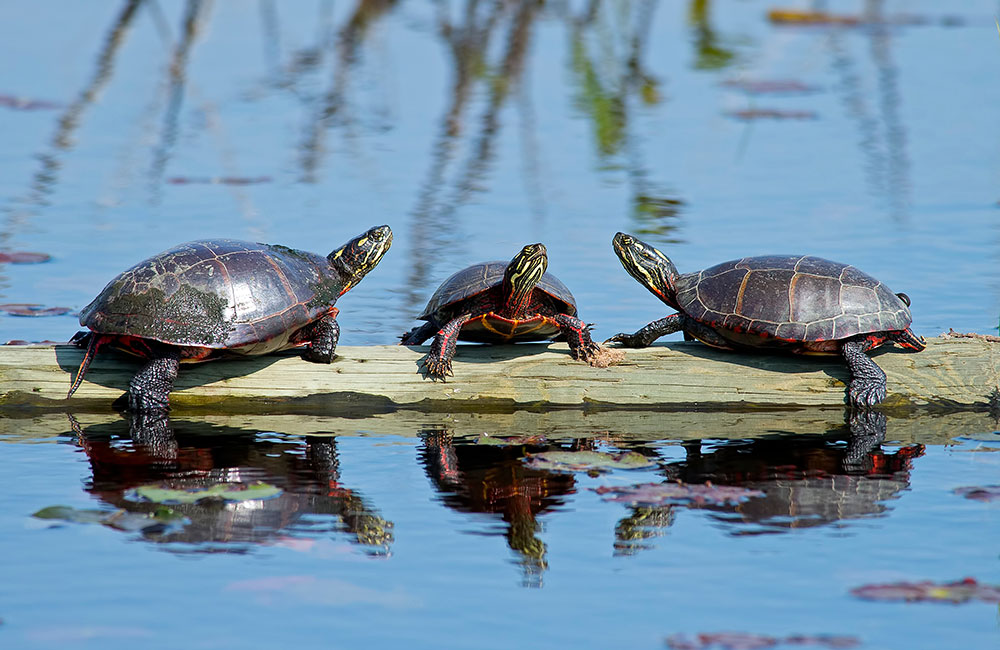 Turtles do not have sex-specific chromosomes, yet they show sex-related differences in aging. "Right now, we have a little bit of data," Riddle said. "We are trying to get data from more species to figure out if that is a general pattern or turtle-specific."
Turtles do not have sex-specific chromosomes, yet they show sex-related differences in aging. "Right now, we have a little bit of data," Riddle said. "We are trying to get data from more species to figure out if that is a general pattern or turtle-specific."2. Organismal biology: Is it all mitochondria and DNA repair?
This section gets at some of the molecular pathways that researchers already know are important when it comes to aging, Riddle said: “Everyone has heard of reactive oxygen species that cause damage and antioxidants that are supposed to be good for you.”
Researchers hypothesize that aging is linked with levels of DNA damage and energy production: “How well your mitochondria work, and how good your cells are at repairing damage from, for example, UV light,” Riddle said. “We don’t know if that carries across a wide range of species, because most of the existing work has been done in flies or mice or worms. That requires us to measure: How good are the mitochondria in young and old individuals — and how good are the cells at repairing DNA? Most of the time, mitochondria are not up to the job as organisms age. But is that true when we go all the way from insects to mammals?”
 Most of the existing work on the role of mitochondria in aging has been done in flies or mice or worms, Riddle said. "Is that true when we go all the way from insects to mammals?"
Most of the existing work on the role of mitochondria in aging has been done in flies or mice or worms, Riddle said. "Is that true when we go all the way from insects to mammals?"3. Phenotypic plasticity: How much wiggle room is there in aging?
How long an animal lives is not set in stone. “If you have two individuals with the exact same genetic makeup and you stick them in a whole different set of environments, what happens?” Riddle said. “As you might guess, it depends on how much food you give them, the temperature, how stressed they are. We want to know how much wiggle room there is in an organism’s lifespan.”
Riddle works primarily in fruit flies. “We have great data sets in fruit flies already that show they live longer in lower temperature,” she said. “And lifespan goes down if you increase the temperature.”
Exploring these questions further “will involve lab experiments and natural experiments,” Riddle said. “Some populations of a species live up on the mountains, and some live down in the valleys,” with contrasting temperatures, she explained. Can researchers find differences in lifespan and aging among these populations?
“This section will also involve certain fish that can change their sex throughout their lives,” Riddle added. “This is one of the most intriguing questions for me. What happens when they make this switch? Do they age the way they started, or is it the pattern for the sex they switch to? And how much is that set in stone, versus what can we manipulate?”
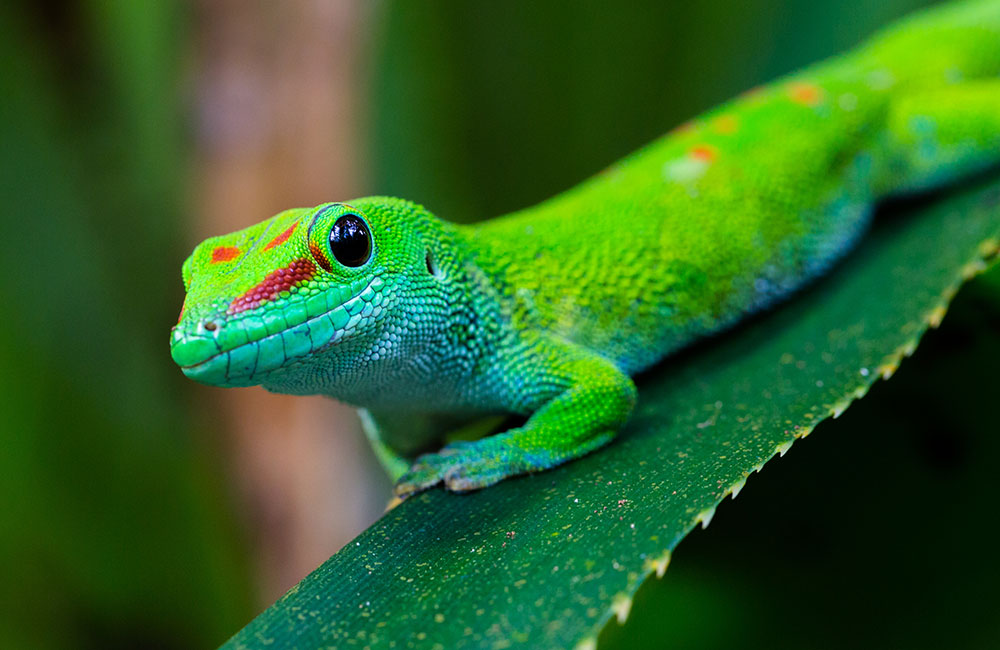 "There are a lot of fish and reptiles with interesting biology but little information about their longevity and how they grow,” Riddle said. IISAGE will be partnering with K-12 classrooms and pet owners to collect invaluable data.
"There are a lot of fish and reptiles with interesting biology but little information about their longevity and how they grow,” Riddle said. IISAGE will be partnering with K-12 classrooms and pet owners to collect invaluable data.Citizen science
IISAGE researchers specialize in everything from fruit flies to bats to geckos. But to achieve its goal of collecting widespread datasets, IISAGE aims to enlist the help of citizen-scientists, including K-12 classrooms across the country.
“We are hoping to engage with pet owners who have fish and reptiles,” Riddle said. “There are a lot of fish and reptiles with interesting biology but little information about their longevity and how they grow.”
Fish are particularly good for K-12 classrooms. “Some of these are just regular aquarium fish that lots of people have, and fish are typically pretty easy to care for,” Riddle said. “We want something that grows pretty fast, so the students have something to watch. Some of the geckos are very long-lived; that would not be a good school project.”
IISAGE will be “setting up a website where we invite pet owners to submit monthly records and pictures of how their pet is growing and how the color patterns change as they get older,” Riddle said. “We will use the data to fill in some of that missing life history information. That data will be a lot more noisy” than data collected by professional scientists; but “given that for a lot of species there is basically no data, any data is better than no data.”
One grant leads to another
The IISAGE project was born out of a series of conversations at a Gordon Research Conference, where Riddle was presenting on her work from a previous NSF-funded project, her CAREER Award, in 2017. “They always give you the afternoon off to talk science” at the conference, Riddle said. She and like-minded colleagues used that time to start talking about what was needed to advance the science of sex differences in aging, she explained: “We met for a few afternoons and put together a draft of what became IISAGE.”









